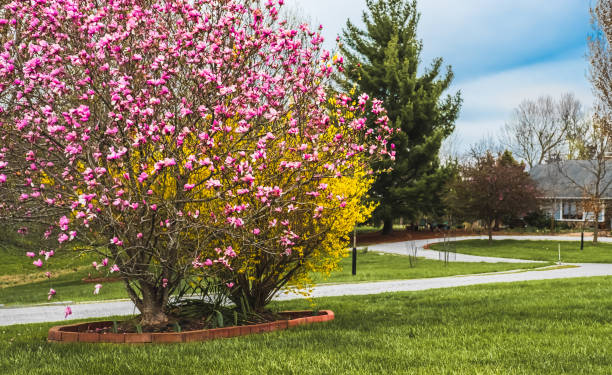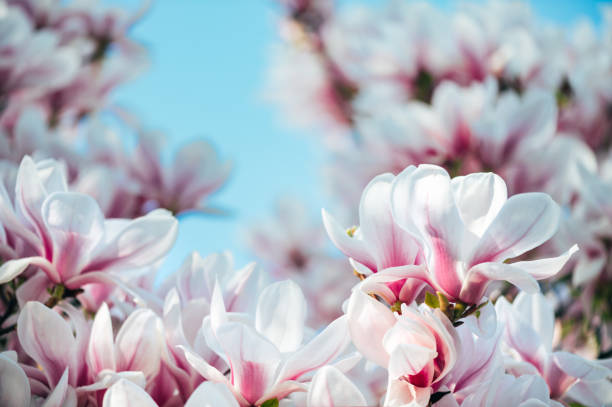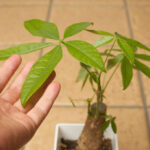
At [Your Company Name], we understand the allure of magnolia trees and their stunning large, fragrant white blossoms. These beautiful trees not only enhance the aesthetics of your landscape but also provide glossy, dark green leaves and an exotic-looking pod that opens in the fall, revealing bright orange-red berries that attract birds and wildlife. In this comprehensive guide, we will delve into the world of magnolia planting and care, equipping you with the knowledge to cultivate and maintain healthy magnolia trees in your own garden.
Magnolia Tree Varieties and Origin
Magnolia trees are native to various regions, including East Asia, the Himalayas, eastern North America, and Central America. These majestic trees can reach heights of 40 to 80 feet, with a spread of 30 to 40 feet. Depending on the species, magnolias may be evergreen, semi-evergreen, or deciduous. Some deciduous varieties even bloom in early spring before the tree leafs out, adding a captivating touch to your landscape.
Choosing the Right Magnolia Tree
When selecting a magnolia tree for your garden, it’s essential to consider your specific climate and growing conditions. Most magnolia trees thrive in USDA Zones 7 through 9, but there are cultivars available that can withstand colder winters in higher zones. To ensure optimal growth and health, it’s advisable to purchase magnolia trees locally, as they are well-suited to the particular environmental conditions of your region.
Magnolia Tree Care Guidelines

Soil and Planting
Choose moist, rich soil with slightly acidic properties to lay a solid foundation for healthy magnolia tree growth. Amending the soil with compost or leaf mold before planting will provide essential nutrients and promote vigorous growth. When planting, ensure the tree’s root ball is level with or slightly above the ground surface. This allows proper water drainage and prevents the root system from becoming saturated.
Watering
Proper watering is crucial during the establishment phase of young magnolia trees. Keep the soil around the base of the tree consistently moist, but avoid overwatering, as excessive moisture can lead to root rot. As the tree matures, it becomes more resilient to drought conditions but may still require supplemental watering during prolonged dry spells.
Fertilization
Fertilizing magnolia trees in early spring when the flower buds begin to swell can enhance their overall health and flowering performance. Opt for a slow-release fertilizer specifically formulated for trees and follow the manufacturer’s instructions for application rates. This controlled-release approach ensures a steady supply of nutrients throughout the growing season.
Pruning and Maintenance

Pruning plays a crucial role in the care of magnolia trees. Proper pruning techniques help maintain the tree’s structure, promote air circulation, and remove damaged or diseased branches. It’s advisable to limit pruning to a minimum, as magnolias have a slow healing process. Prune any broken branches as soon as possible after damage occurs. For pruning aimed at shaping or thinning the tree, it’s best to wait until after flowering to minimize the risk of reducing next year’s blooms.
Dealing with Fallen Leaves and Lawn Maintenance
Magnolia trees often shed a significant number of large, crispy leaves, which can pose a challenge for lawn maintenance. To manage fallen leaves effectively, some homeowners choose to remove the lower limbs of the magnolia tree. However, leaving the lower limbs intact allows them to drape to the ground, naturally concealing the fallen leaves. This shade also inhibits grass growth and provides a natural mulch that breaks down over time, enriching the soil with nutrients.
When mowing around a magnolia tree, always direct the lawn mower away from the tree to prevent flying debris from damaging the tree’s bark and wood. String trimmers should also be used with caution, maintaining a safe distance to avoid unintentional injuries.
Conclusion
With their captivating blossoms and elegant presence, magnolia trees are a wonderful addition to any landscape. By following our comprehensive guide to magnolia tree care, you’ll be equipped with the knowledge and techniques to nurture and grow healthy magnolia trees in your own garden. Remember to choose the right variety for your climate, provide proper soil and watering conditions, and practice appropriate pruning and maintenance. With these guidelines in mind, your magnolia trees will flourish, adding beauty and charm to your outdoor space for years to come.






